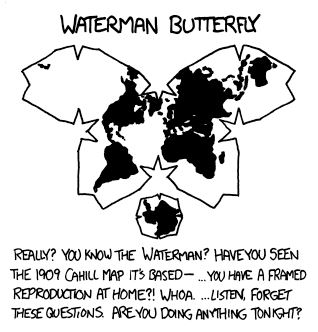

The fact that oxygen may have shot up to modern levels really early on for a bit fascinates me in particular.
Formerly u/CanadaPlus101 on Reddit.


The fact that oxygen may have shot up to modern levels really early on for a bit fascinates me in particular.


This is either bait, or you need to get the police involved for the kids and find somewhere safer/saner to live yourself.


So how much time will this add to most trips, in the end?
Edit: I have no opinion on this policy. I don’t even know which side is downvoting me, lol.


What about just enforcement?


Yes, I’m pretty sure that’s the whole point. I’m guessing they could pick one or two Central American or other African countries and get the same balance.
Also, picking on SA specifically smacks of the whole apartheid hangover thing that’s going on.


We’d love to. You know we get it first and in higher concentration, right? Not to mention all our shit that burns down in the process.
And I mean, it’s from the climate change that you helped make as well…


Only sort of facetiously, it’s all filmed up here anyway.
Yes, the tech and media giants are harder to avoid. Ali Express has left a lot to be desired as an Amazon replacement, although I haven’t quite given up. For streaming, CBC Gem is publicly funded. The boycott is mainly targeted at physical products.


If your water splitters are running, you should really just use the electricity they’re on to generate heat. Fire is especially dangerous in enclosed spaces.
Also for load balancing you could constantly be splitting water into hydrogen and oxygen, then react them back into water when you need a large amount of energy at once as an alternative to electrical batteries which degrades less over time, if heat is all you want at least.
Some kind of combustion with oxidiser built in might always have an application. Chemical rocket boosters maybe? (Hydrogen specifically can also be turned back into electricity with like 80% efficiency in a fuel cell, FYI, although it’s sooo hard to store)
I suppose there might be The Martian-esque edge cases as well, where more complex, controlled chemical reactions are temporarily impractical, but like in the book and movie that’s highly unsustainable and you’ll die if you’re stuck doing it for long.


You said turbines specifically. Parsons invented those around the turn of the 20th century.
Before that, it was the chugga-chugga kind of steam engine. They’re a lot simpler to design and machine, and don’t require the really high RPMs to operate, but then again can break in many different ways a turbine can’t.


Wow, that’s amazing. I’m guessing the then very-limited suffrage had to do with it. It would have been just white landowning males at the time, right?


https://en.wikipedia.org/wiki/List_of_problems_in_loop_theory_and_quasigroup_theory
And I’m pretty sure a bunch of other pages related to loops and quasigroups. I don’t still have them open, though.


I mean, that’s 20th century, or (IIRC) just before depending on the level of tech maturity you require. The 19th century ran on pistons.


Burning random stuff for heat requires cheap, abundant oxygen, though.


Well, if that counts, addition also remains very popular.


I mean, if all the good secret information is going over fax and everyone knows it, sure, people will hack it. Blackhats are in it for the money, not to work with the newest technology. Most of what they do is already mind-numbing grinding.
The main security there is just the security of whatever phone line it’s going over. And that’s assuming you never dial a wrong number…


Please don’t tell me you buy that “they can’t be hacked”. It’s pretty much on the same tier as email.


It’s not a matter of in front or behind. It’s just brightness.
Presumably, it’s possible to see them or the stars anyway, just by subtracting out the blue glow of the air, but normal human eyes can’t do that.


I’m curious how 1840 came up.


Stagnant wages aren’t that new. 2008 was worse. The rest, yeah.
Well, that’s good to hear. Hopefully it helps, and I’d also suggest that it means they do care, at least a bit.
Maybe they do need to give you more time to vent, it’s hard to say without being there. In general, we on the internet don’t know you and can’t have enough information to help you the way a therapist can.